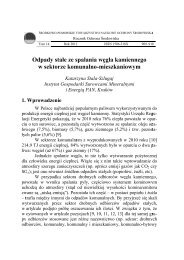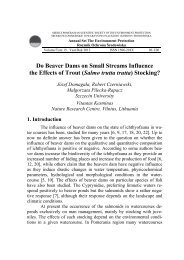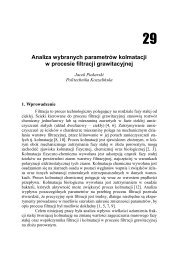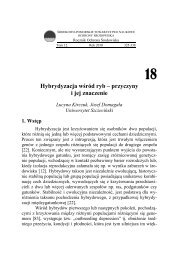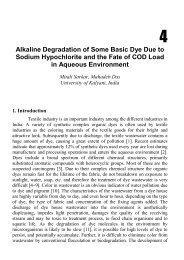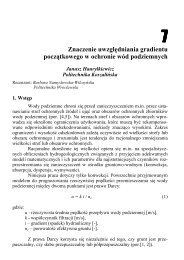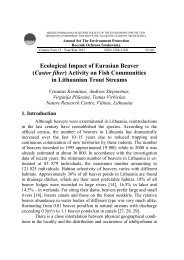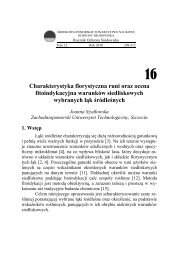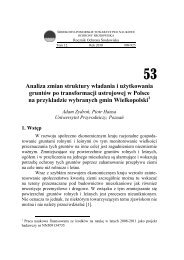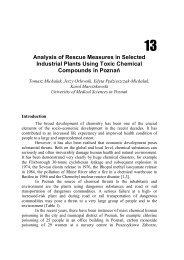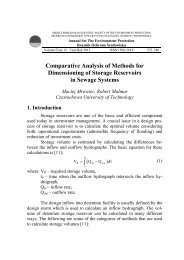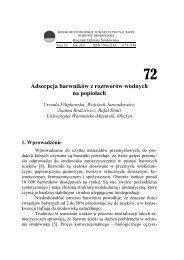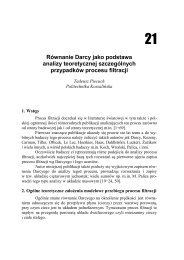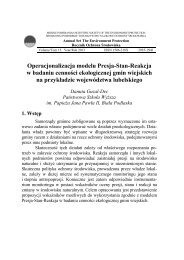Metody ługowania zanieczyszczeń z odpadów mineralnych w ...
Metody ługowania zanieczyszczeń z odpadów mineralnych w ...
Metody ługowania zanieczyszczeń z odpadów mineralnych w ...
Create successful ePaper yourself
Turn your PDF publications into a flip-book with our unique Google optimized e-Paper software.
<strong>Metody</strong> <strong>ługowania</strong> <strong>zanieczyszczeń</strong> z <strong>odpadów</strong> <strong>mineralnych</strong>…<br />
Methods of Leaching Contaminants from Mineral Waste<br />
in the Aspect of its Potential Utilization<br />
in Hydrotechnical Construction<br />
Abstract<br />
The research conducted in static and dynamic conditions was aimed at determining<br />
the vulnerability of soluble compounds contained in ashes to leaching with the<br />
objective to define the quantity and type of contaminants which may affect soil, ground<br />
and surface waters in the case of ash utilization or disposal on land surface.<br />
Silica, aluminum and iron oxides are the basic compounds of fly ashes while<br />
calcium, magnesium, potassium as well as other oxides occur in significantly less<br />
amounts. Taking into account the chemical composition recalculated into SiO2, CaO,<br />
Al2O3, SO3, the following 3 categories of ashes have been recognized in Poland: silica,<br />
aluminum and calcium ashes.<br />
Solubility tests of the Polish fly-ashes showed that depending on the ash category,<br />
0,5% (aluminium ashes) up to 10% and more (calcium ash) of their mass may<br />
dissolve in water.<br />
In different conditions of the leaching processes, the vulnerability of fly ashes<br />
to the release water soluble compounds contained in them may vary. The main substances<br />
leached from the analyzed ashes ( in descending order) were sulphates, calcium,<br />
sodium and chloride ions, while the trace elements included chromium, cadmium and<br />
lead. The leachability of other elements was insignificant.<br />
Eluates from the investigated fly-ashes were characterised by an elevated reaction<br />
and the content of some ions (SO4 -2 , Cr 3+ , Cd 2+ , Pb 2+ ) exceeding the permissible<br />
concentrations compared to the standards for wastewater discharged to waters or soil,<br />
which in consequence may lead to a negative impact on the water environment in the<br />
vicinity of the disposal sites.<br />
A comprehensive environmental impact analysis has been made based on the<br />
effective legal regulations (including Geological and Mining Law, Waste Act and its<br />
executive regulations). Doubts have been raised if determining the potential risk to the<br />
environment based on the leachability test is sufficient as it does not reflect the volume<br />
of the leached substances under natural conditions. Tests conducted in dynamic conditions<br />
showed that the total load of the leached substances was significantly higher compared<br />
to the leachability test data. The dynamic method (alternative I and II) simulates<br />
the course of the leaching processes taking place in natural conditions and allows foreseeing<br />
the concentration distribution the leached contaminants in a given time.<br />
The conducted research proved the real-time dynamic leaching method more<br />
reliable in conducting a preliminary environmental impact assessment.<br />
Also as a result of the studies the thesis has been confirmed that fly ashes are<br />
vulnerable to the release of soluble compounds contained in them and thus show some<br />
negative tendencies in their impact on the environment. Disposal of fly ashes in landfills<br />
or their underground storage in mines may cause degradation of surface and groundwaters<br />
due to the penetration of the leachable compounds from waste in the areas of its disposal.<br />
Tom 10. Rok 2008 219



